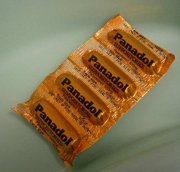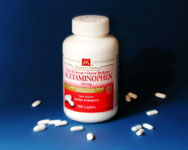Which do you think is more effective for relieving your child's pain or fever, acetaminophen (e.g., Tylenol) or ibuprofen (e.g., Advil)? Which is safer? Although these drugs are the most frequently used over-the-counter medications for treating children's pain and fever, it turns out that even the experts disagree.
We used a special statistical technique called "meta-analysis" to help resolve this disagreement. It involves mathematically combining the data from all available high quality studies addressing a particular research question, and then reanalyzing the data as though they were from one very large study conducted at different times and places. We can generally have greater confidence in findings from a meta-analysis than in those from any individual study because a meta-analysis is based on all of the best available evidence on a given topic, rather than on just the data gathered for one individual study.
We conducted meta-analyses to address the following three questions about ibuprofen and acetaminophen: (1) which works best for treating children's pain; (2) which works best for treating children's fever; and (3) which is safer?
The children participating in the studies we included in our meta-analyses were aged two to eighteen years, and were experiencing either fever or moderate-to-severe pain. Two very important characteristics of these studies were that the children were randomly assigned to receive a single dose of acetaminophen or ibuprofen, and that they did not know which drug they were receiving. The dosages of each drug were within the range that health professionals are allowed to prescribe, but varied from study to study. We were able to take this variation into account when analyzing the data.
Which Drug Is Better For Treating Pain?
Our meta-analysis of research comparing the effectiveness of ibuprofen versus acetaminophen for treating children's pain was based on 186 children from three studies. When pain was measured twp hours after taking whichever drug, and again after four hours, we found no evidence that a single dose of ibuprofen (4 to 10 mg/kg) was any better or worse than a single dose of acetaminophen (7 to 15 mg/kg). That is, it did not appear from these studies that a single dose of one drug was any better than the other for treating moderate-to-severe pain.
We regard this as a tentative conclusion, however, because it was only based on three small pain studies. Moreover, these studies only considered dental pain and sore throat pain. When more studies are conducted and published that compare ibuprofen and acetaminophen in the context of other common kinds of pain, such as headache, muscular aches, and cold and flu pain, we can incorporate them into a new meta-analysis and draw conclusions with greater confidence than the one we report here.
Which Is Better For Reducing Fever?
There has been more research comparing the two drugs for treating children's fever than there has for treating children's pain. Our meta-analysis of the fever research was based on 1,078 children from nine studies. We found that a single dose of ibuprofen (4 to 10 mg/kg) did a better job at reducing fever than a single dose of acetaminophen (10 to 15 mg/kg), when measured two, four and six hours after taking the drugs. We also found that the superiority of ibuprofen over acetaminophen for reducing fever was even more pronounced four and six hours after taking the drug, than it was two hours after. The important issue of when such control of fever is desirable is a separate question that was not addressed in this meta-analysis or in the primary studies.
Which Drug Is Safer For Single-Dose Use?
Our meta-analysis of studies examining the safety of ibuprofen versus acetaminophen was based on 1802 children from 17 studies. We examined safety in terms of negative side effects like nausea, sweating, or upset stomach that occurred during the observation period of each study. The most typical observation period in these studies was 48 hours, but it was as short as four hours in two studies and as long as 14 days in another. In nine of the studies, some children were given a placebo instead of one of the drugs. That is, they were given something that looked like one of the drugs, but was in fact more like a sugar pill with no drug-like properties. This allowed us to compare the safety of the drugs to a substance that did not have any active ingredients.
We found that negative side effects were quite rare overall following a single dose, and that there was no evidence that ibuprofen (4 to 10 mg/kg) or acetaminophen (7 to 15 mg/kg) differed from each other or from a "sugar pill" in safety.
The Bottom Line
Our meta-analyses of high quality studies directly comparing the safety and efficacy of ibuprofen versus acetaminophen for treating children's pain and fever lead to three general conclusions. Right now, the best available evidence we have doesn't support a preference for one drug over the other for treating children's pain; rather, ibuprofen (4-10 mg/kg) appears to be as effective as acetaminophen (7-15 mg/kg). For treating children's fever, however, a single 5-10 mg/kg dose of ibuprofen does a better job than a 10-15 mg/kg dose of acetaminophen. And the good news for both drugs is that the side effects from taking a single dose of either one were not any different from taking a "sugar pill."
Some Important Caveats
As you make decisions in consultation with your physician about which drug to use to treat your child's pain or fever, keep in mind that our research was only examining what happens when children take a single dose of either drug to treat fever or moderate-to-severe pain, rather than what happens when they take either drug for an extended period of time. We also did not review the evidence (which is very limited) on the efficacy and safety of the drugs for children younger than two years. Finally, bear in mind that our findings were based on particular dosages of the drugs (tailored to a child's weight and/or age). The effectiveness and safety of either drug depends partly on the dosage your child takes--and you should follow the advice of your family physician and/or pharmacist regarding that.
David Perrott earned his Ph.D. in Social Psychology from Northwestern University, of New South Wales, Sydney, Australia.
COPYRIGHT 2004 Pediatrics for Parents, Inc.
COPYRIGHT 2005 Gale Group



